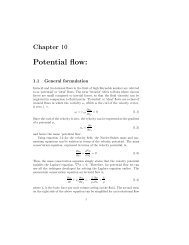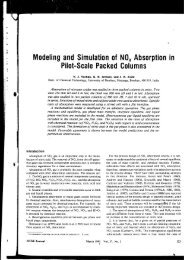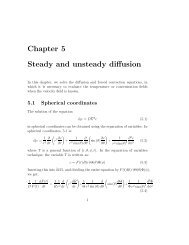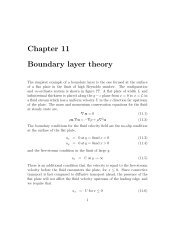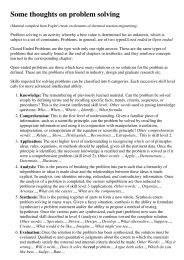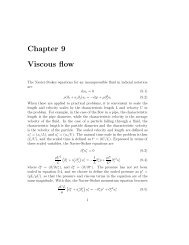Chapter 3 Unidirectional transport - Chemical Engineering ...
Chapter 3 Unidirectional transport - Chemical Engineering ...
Chapter 3 Unidirectional transport - Chemical Engineering ...
- No tags were found...
Create successful ePaper yourself
Turn your PDF publications into a flip-book with our unique Google optimized e-Paper software.
12 CHAPTER 3. UNIDIRECTIONAL TRANSPORTThis is inserted into the conservation equation 3.16, and the equation isdivided by the production ΘZ, to obtain1 dΘΘ dt = 1 d 2 Z(3.42)∗ Z dz ∗2In equation 3.42, the left side is only a function of t ∗ , while the right sideis only a function of z ∗ . From this, it can be inferred, as follows, that thesetwo functions have to be constants independent of z ∗ and t ∗ . To infer this,assume that these two functions are not constants, and that the left sidevaries as t ∗ is varied, and the right side varies as z ∗ is varied. In this case,if we keep z ∗ a constant and vary t ∗ , then the left side of 3.42 varies, whilethe right side remains a constant, and so the equality is destroyed. The onlyway for the equality to hold, if the left side is only a function of t ∗ and theright side is only a function of z ∗ , is if the two sides are constants.The solution for Z is first obtained by solving1 d 2 ZZ dz = ∗2 −α2 (3.43)where α is a positive constant. The reason for choosing the right side of3.43 to be negative will become apparent a little later. The solution for thisequation isZ = C 1 sin (αz ∗ ) + C 2 cos (αz ∗ ) (3.44)where C 1 and C 2 are constants to be determined from the boundary conditions.The boundary condition c ∗ u = 0 (Z = 0) at z ∗ = 0 is satisfied forC 2 = 0. The boundary condition ca u = 0 at z ∗ = 1 is satisfied if α = (nπ).Therefore, the solution for Z which satisfied the boundary conditions in thez ∗ coordinate isZ = C 1 sin (nπz ∗ ) (3.45)where n is an integer.The solution for Θ can now be obtained from the equationThis equation is solved to obtain1 dΘΘ dt = ∗ −α2 = −n 2 π 2 (3.46)Θ = C 3 exp (−n 2 π 2 t ∗ ) (3.47)





